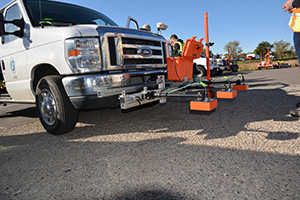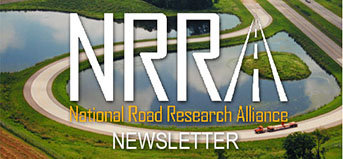NRRA Newsletter: October 2018
MnDOT Launches New Geogrid Spec
The Minnesota Department of Transportation has published a new specification regarding geogrid use. The video below is an overview of the spec.
Project Profile: Fiber-Reinforced Concrete Roundabout
The fiber-reinforced pavement research being done by the NRRA is not limited to test cells at MnROAD. This summer, MnDOT installed a unique roundabout in Sleepy Eye, MN that incorporated fiber-reinforced concrete.
At least two things made this project a first of its kind project in MN. First, we haven’t used fiber in the mix for a roundabout before. Second, and most importantly, there were no joints cut in the isolated circle or “donut” of the roundabout.
Charlie Kremer, District 7 Materials Engineer has seen many roundabouts built in the Mankato District. His concerns with all of the odd shaped panels sawed and cracking in the roundabouts led him to search out an alternative to a traditional jointed roundabout.
The MnDOT Concrete Engineering Unit proposed a fiber reinforced concrete roundabout with no joints after seeing a presentation at the National Concrete Consortium meeting.
The problem with cutting joints in a round shape, rather than square panels, makes the cracking more difficult to predict, says Rob Golish, Assistant Concrete Engineer at MnDOT’s Office of Road Research.
MnDOT knows the pavement will crack where it wants, so the inclusion of fiber reinforcement should hold the cracks tighter together, keeping them from growing too large.
Even though joints were not sawed into the concrete, MnDOT decided to try and influence the location of the cracks by putting in 15 inch long notches every 4 feet on the outside edges of the roundabout.
Early information shows some of the cracking initiated at the ends of the notches, while other cracks occurred within a foot or two of the notch. After the first couple of weeks, the roundabout had cracked into four pieces.
This kind of project has never been tried before, and MnDOT will be watching it carefully to see where it cracks, how it cracks and if the fibers factor into the life of the roundabout.
Intelligent Construction Technologies ETG Meeting
On October 10, the Intelligent Construction Technologies (ICT) - Expert Task Group (ETG) met in Minnesota, hosted by MnDOT. The ICT-ETG group meets at least twice a year to discuss the technologies and innovations that have the attention of the paving industry.
It can be a little confusing because there is also an NRRA ICT Team, but that one just started. This ICT - ETG has been together and promoting construction innovation since 2012.
Some of the technologies that are front-burner innovations for ICT include:
- Paver-Mounted Thermal Profiles (PMTP)
- Intelligent Compaction (IC)
- Dielectric Profiling (DP)
- Intelligent Construction Data Management (ICDM)
The expert task group includes representatives from seven state DOTs, many private companies and academics from around the U.S. George Chang, Director of Research for The Transtec Group, started the ICT  - ETG effort and still continues to keep this group running. One important discussion during the meeting was a data quality assurance plan. That is essentially a way to verify the data generated by these technologies as it comes from the contractors. Says Chang, “we have very good ideas of how to proceed next. Those ideas will be further developed and debated and selected for next year’s research so we can do field trials and show the world that we can do it.”
- ETG effort and still continues to keep this group running. One important discussion during the meeting was a data quality assurance plan. That is essentially a way to verify the data generated by these technologies as it comes from the contractors. Says Chang, “we have very good ideas of how to proceed next. Those ideas will be further developed and debated and selected for next year’s research so we can do field trials and show the world that we can do it.”
Another one of the topics discussed, said Rebecca Embacher, Advanced Materials Technology Engineer for MnDOT, involved advancements in Building Information Modeling (BIM) for pavements. The FHWA Every Day Counts (EDC) promotes the use of BIM concepts and other proven but underutilized innovations. Embacher explains that our DOT’s have some catching up to do in this discipline relative to pavements. There is currently a pooled fund (TPF-5 [372]) for BIM for Bridges and Structures, but nothing that focuses on pavements. Consequently, the Wisconsin Department of Transportation is proposing that a pooled fund be established for BIM for pavements. The proposal is being shared in hopes of stirring up interest from other DOTs to join as partner agencies.
“This is a great industry group because when we meet, we come up with solutions for the industry,” says Chang.
Additional Pavement Research Resources:
- Our Flexible team has a new short-term research report on Longitudinal Joint Construction
- A great overview of the NRRA that appeared in seven regional magazines
- Webinars on Nov. 7 and Dec. 5: Fiber Reinforced Concrete Project (CPAM)
- TRB recordings titled "Benefits of Computational Modeling for Geotechnical Engineers" featuring our own Derrick Dasenbrock (MnDOT)
Research Pays Off November: NRRA Teams Reporting
Nov. 20: We are going to do something a bit different in November. This month our NRRA Teams--Flexible, Rigid, Geotech and Preventive Maintenance--will review the 2017 projects one year out. Each presentation will be lead by the principal investigator.
9 a.m.: Bora Cetin, Determining Pavement Design Criteria for Recycled Aggregate Base and Large Stone Subbase
9:30 a.m.: Manik Barman, Performance Benefits of Fiber-Reinforced Thin Concrete Pavement and Overlays
10 a.m.: Hamed Sadati, Reduced Cementitious Material in Optimized Concrete Mixture
10:30 a.m.: Joe Korzilius, Maintaining Poor Pavements
1 p.m.: Eshan Dave, Developing Best Practices for Rehabilitation of Concrete with Hot Mix Asphalt (HMA) Overlays related to Density and Reflective Cracking
1:30 p.m.: Lev Khazanovich, Evaluation of Long-Term Impacts of Early Opening of Concrete Pavements
2 p.m.: Braun Intertec, Effective Long Lasting Partial Depth Joint Repairs for Challenging Conditions
2:30 p.m.: American Engineering Testing, Cold Central Plant Recycling (CCPR)


